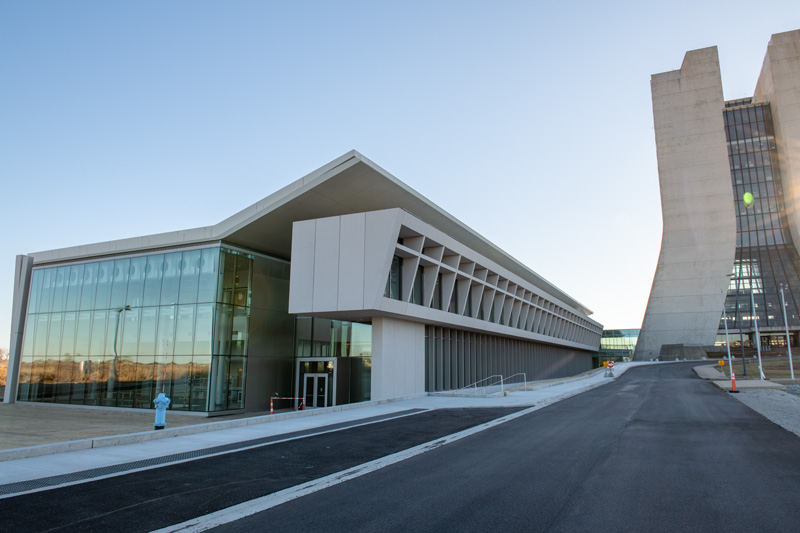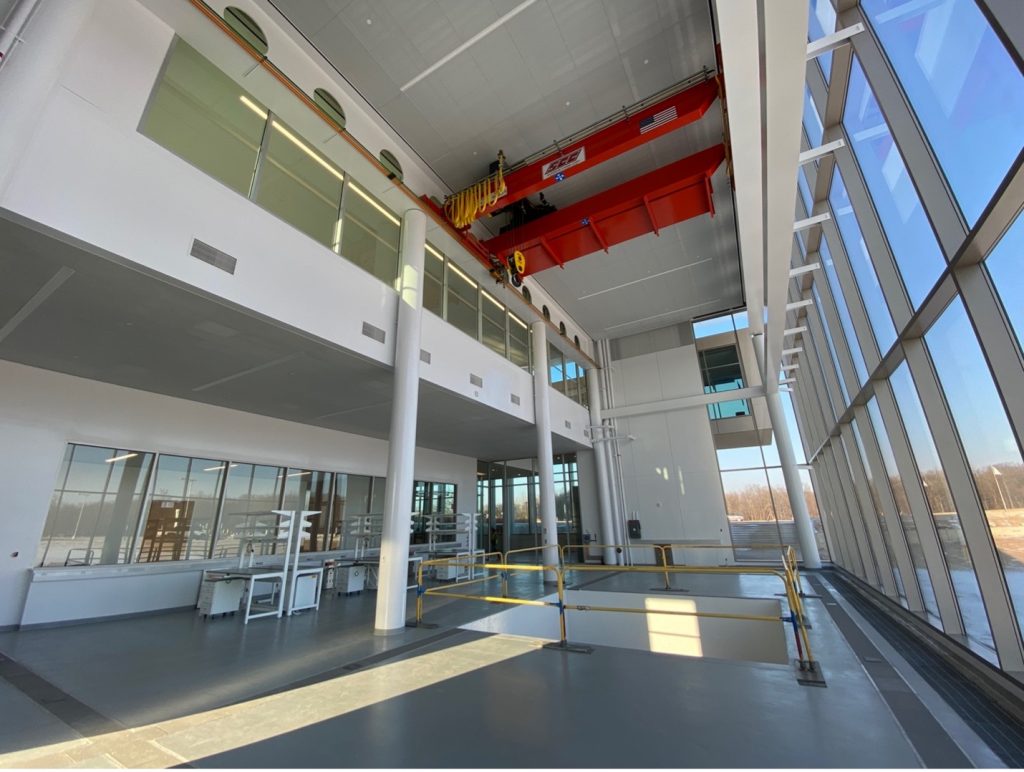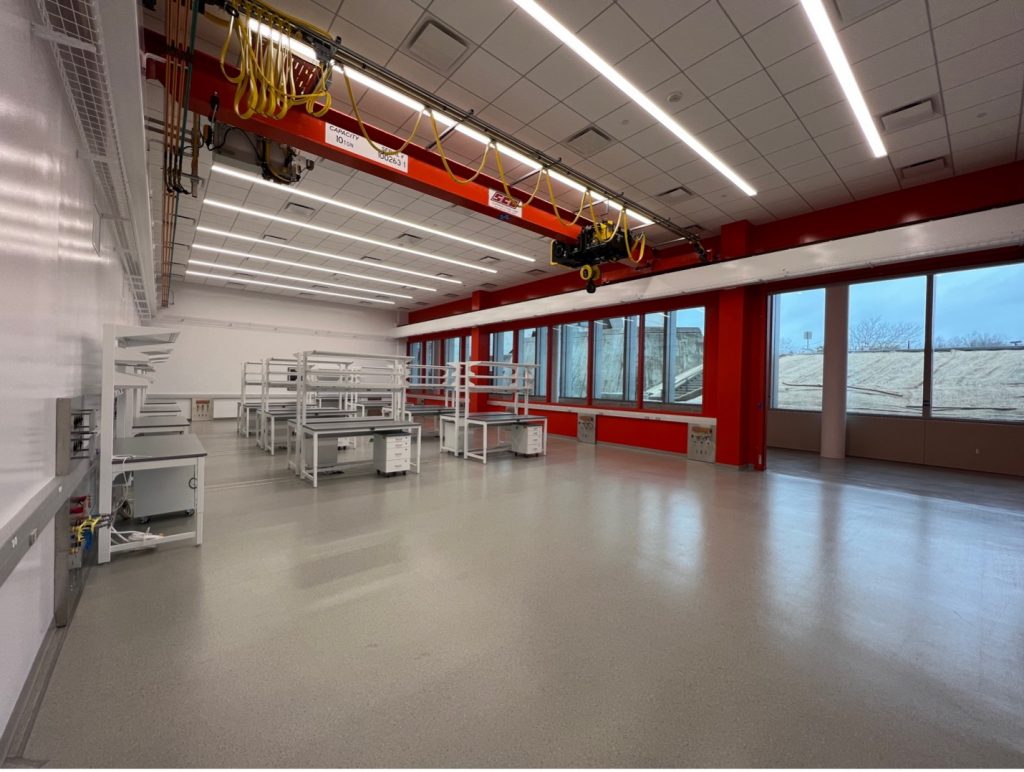The Integrated Engineering Research Center at the U.S. Department of Energy’s Fermi National Accelerator Laboratory is about to become the place to tackle the technical challenges of particle physics experiments. It will be the new home of engineers and technicians working on high-energy physics projects, like the Fermilab-hosted Deep Underground Neutrino Experiment and the proposed next-generation cosmic microwave background project called CMB-S4.
The brand-new, 80,000-square-foot building provides space for research, design, construction and testing of technologies. It will host state-of-the-art infrastructure for the development of technologies for particle detectors, including electronics and application-specific integrated circuits. And it was built to kindle innovation across the lab.
“To me, the most important thing is getting a lot of people together and no longer spread out all over the Fermilab site,” said Leo Bellantoni, a senior scientist at Fermilab working on the project. “It’s going to be a great facility for getting stuff launched.”

The brand-new, 80,000-square-foot Integrated Engineering Research Center provides space for research, design, construction and testing of technologies for particle physics research at Fermilab. Photo: Ryan Postel, Fermilab
Centrally located next to Fermilab’s iconic, 16-story Wilson Hall, the sustainably built center has two floors, with lab space on the ground floor and office and conference space on the second. Two of these labs will provide much-needed space dedicated to DUNE-related work — one cold lab for work with cryogenic liquids, and one warm lab for non-cryogenic work. These new labs will provide space for DUNE engineers and scientists to develop and test modules for neutrino detectors while streamlining workflows and providing opportunities for more collaboration.
“One of the draws of bringing people to Fermilab is having the facilities that would be difficult for them to have of similar scale or complexity at their university,” said Jen Raaf, a senior scientist working on DUNE. “So having things like this will definitely draw more people to come here, which feeds into this nice environment where you get to talk to people from different backgrounds and spark new ideas.”
One of the first DUNE projects to go into the cold lab will be work on the photon detection system for the second detector module planned for the DUNE far detector in South Dakota. This detector module will have X-ARAPUCA photon detectors on the cathode, at minus 300 kilovolts, surrounded by cryogenic liquid. This has never been done before, according to Ryan Rivera, an electrical engineer and deputy head of the Real-time Processing Systems Division. To accomplish it, engineers are testing the use of optical fiber to send power and signals to and from the detector.
“At the engineering building, we want to keep optimizing this power-and-signal-over-fiber system to get the most we can out of it, the most efficient operation,” Rivera said. “There’s implications for even the proposed far detector three. It’s a perfect time for R&D to come out of the engineering building that could be the spark for decision-making for far detector three.”

View of the DUNE Cold lab inside the IERC building, which includes a 25-ton overhead bridge crane and space for the testing of DUNE prototype detector components with liquid argon. Photo: Brian Rubik, Fermilab
In addition to DUNE, other projects and experiments will have R&D labs on the ground floor of the new building. Researchers working on CMB-S4 will use lab space for developing and testing modules and electronics for detectors that will end up as components of telescopes in the South Pole and Chile. According to Adam Anderson, a Wilson fellow and associate scientist working on CMB electronics, the new space will allow for the testing of about 500 of these modules, thanks to a new grove of dilution refrigerators.
“That’s absolutely necessary for doing this testing activity for CMB-S4 because we have so many modules that we need to test,” Anderson said. “The ability to run large numbers of cryostats is a requirement for being able to do this work.”
While the new labs for DUNE, CMB-S4 and other experimental projects moving into the new building will enhance the R&D process with more space and new equipment, the relocation will also free up cleanroom and lab space in Fermilab’s Silicon Detector Facility. The reclaimed space will become available for the testing and mass production of detector components for the high-luminosity upgrades of the CMS experiment at the Large Hadron Collider.
Perhaps most importantly, the Integrated Engineering Research Center, which was funded by the Science Laboratory Infrastructure program within DOE’s Office of Science, will allow for more scientific collaboration between scientists, engineers and technicians. It will bring together engineers and scientists who have worked on related topics in locations spread out across the 6,800-acre Fermilab site. For Rivera’s work on DUNE, for example, this will mean more frequent interactions with scientists in Wilson Hall to keep everyone involved on the same page.
“It’ll be the first time at such a large scale all this research can be happening doors away from each other,” he said. “So, there’s a lot of unpredictable synergy that can happen.”

Future research on charge-coupled devices, which scientists use to detect photons, will take place in the CCD lab on the ground floor of IERC. This lab is an example of the typical high-bay space that the building provides. The infrastructure in these spaces provides clean power, grounding bars, compressed air, nitrogen and vacuum hook-ups. Photo: Dan Fograse, Fermilab
These interactions can also be facilitated more easily for scientists and engineers working on astrophysics experiments, according to Anderson. By moving closer to Wilson Hall, he hopes for increased communication between experimentalists and theorists, which in turn can yield more scientific developments from collaborations.
“People who are primarily working in Wilson Hall in astrophysics, like the theory people, also express that they find it interesting to be closer to the experimental work,” he said. “They learn something from us as much as we learn from them.”
According to Bellantoni, the benefits of being near Wilson Hall and in the same building also go beyond just scientific developments. Bringing people closer together not only helps the scientific process but fosters community as well.
“All the labs have big windows, and people are going to walk by and look in and maybe be curious about what their coworkers are doing,” he said. “Just having people in the same space is a tremendous benefit.”
The construction of the Integrated Engineering Research Center was funded by the Science Laboratory Infrastructure program within the Department of Energy Office of Science.
Fermi National Accelerator Laboratory is supported by the Office of Science of the U.S. Department of Energy. The Office of Science is the single largest supporter of basic research in the physical sciences in the United States and is working to address some of the most pressing challenges of our time. For more information, please visit science.energy.gov.
